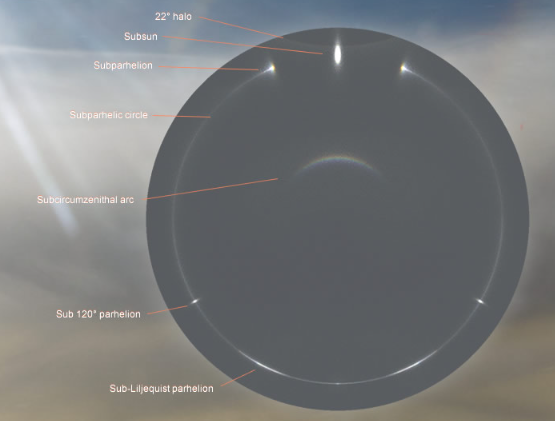OPOD - Parhelia & Subparhelia through a glass darkly
OPOD - Parhelia & Subparhelia: A Spectacular Optical Phenomenon
Have you ever witnessed a breathtaking display of atmospheric optics? The phenomenon known as sundogs and subparhelia can create a mesmerizing spectacle in the sky. These optical phenomena involve reflections and refractions of sunlight through ice crystals in the atmosphere, resulting in stunning halo formations. In this article, we will delve into the intricacies of sundogs and subparhelia, exploring their formation and the unique characteristics that make them so captivating.
Sundogs and Subparhelia: Reflections in the Sky
Sundogs, also known as parhelia, are bright spots of light that appear on either side of the sun. They are formed when sunlight passes through hexagonal ice crystals with vertical side faces inclined at an angle of 60 degrees to each other. The light undergoes multiple reflections between the top and bottom faces of the crystals, resulting in an even number of reflections. As a result, the sun ray exits downwards and contributes to the formation of a sundog.
On the other hand, subparhelia are lesser-known but equally fascinating halo formations. They flank a subsun, which is a point on the horizon below the sun. Subparhelia are created when sunlight passes through ice crystals with an odd number of reflections. Unlike sundogs, subparhelia can only be observed from specific vantage points, such as an aircraft or a mountainside. This unique perspective adds to their allure, as they appear as mirror images beneath the sundogs but with subtle differences.
The Journey of Light Through Ice Crystals
To truly appreciate the beauty of sundogs and subparhelia, it's important to understand the intricate path that light takes through ice crystals. As sunlight enters the crystals, it reflects up and down between the large hexagonal top and bottom faces. The number of reflections determines the direction in which the sun ray emerges from the crystal. An even number of reflections leads to a downward exit, contributing to a sundog. Conversely, an odd number of reflections results in an upward emergence, creating a subparhelion.
A Glimpse through a Glass Darkly
Imagine witnessing the grandeur of sundogs and subparhelia through the windows of an aircraft or a glass-bottomed plane. The wide expanse of the sky would reveal a captivating scene, showcasing the vibrant colors and intricate halo formations. Unfortunately, such views are not easily accessible to everyone. However, with advancements in technology, simulations like HaloSim can replicate these atmospheric phenomena, allowing us to experience their splendor from the comfort of our homes.
Exploring the Subparhelic Circle
Beyond the subparhelion lies another fascinating feature known as the subparhelic circle. This circular halo encircles the subhorizon "sky" and is characterized by its white color. The subparhelic circle extends outward from the subparhelion, adding an extra layer of complexity to the overall display. While it may not be as well-known as sundogs or subparhelia, the subparhelic circle contributes to the overall enchantment of this optical phenomenon.
Conclusion
The world of atmospheric optics never ceases to amaze us with its intricate displays. Sundogs and subparhelia, with their reflections and refractions of sunlight through ice crystals, create a stunning spectacle in the sky. Understanding the formation of these halos and their unique characteristics adds to our appreciation of their beauty. Although witnessing these phenomena firsthand may be rare for many, simulations and photographs allow us to immerse ourselves in their magnificence. So, next time you gaze at the sky, keep an eye out for these captivating optical wonders and let yourself be enthralled by their ethereal presence.

Dogs & Subdogs
Unusually complete sundogs, subparhelia and subsun between Munich and Paris imaged by Mark McCaughrean. Air France windows rendered the magnificent scene through a glass darkly. Image ©Mark McCaughrean

Sundogs flank the sun. Beneath them and the horizon, not quite mirror images, subtly different – subparhelia – flank a subsun.
All these halos involve reflections.
Sundogs and subparhelia are very similar. They form when sun rays pass between vertical side faces of horizontal plate crystals inclined 60° to each other. But their paths through the ice are not smooth. The light reflects up and down between the large hexagonal top and bottom faces.
An even number of reflections and the sun ray exits downwards to contribute to a sundog.
An odd number and the ray emerges upwards to count towards a subparhelion seen only from an aircraft or mountainside.

Had the display been observed from the wide windows of the flight deck - or better from a glass bottomed aircraft - it would have been quite a sight.
At left, a HaloSim ray tracing simulation looking straight downwards.
Views like this can be generated by bright lamps shining into diamond dust displays.
Extending out from the colourful subparhelion is a white subparhelic circle. It probably encircled the subhorizon 'sky'.
Note: this article has been automatically converted from the old site and may not appear as intended. You can find the original article here.
Reference Atmospheric Optics
If you use any of the definitions, information, or data presented on Atmospheric Optics, please copy the link or reference below to properly credit us as the reference source. Thank you!
-
<a href="https://atoptics.co.uk/blog/opod-parhelia-subparhelia-through-a-glass-darkly/">OPOD - Parhelia & Subparhelia through a glass darkly</a>
-
"OPOD - Parhelia & Subparhelia through a glass darkly". Atmospheric Optics. Accessed on December 22, 2024. https://atoptics.co.uk/blog/opod-parhelia-subparhelia-through-a-glass-darkly/.
-
"OPOD - Parhelia & Subparhelia through a glass darkly". Atmospheric Optics, https://atoptics.co.uk/blog/opod-parhelia-subparhelia-through-a-glass-darkly/. Accessed 22 December, 2024
-
OPOD - Parhelia & Subparhelia through a glass darkly. Atmospheric Optics. Retrieved from https://atoptics.co.uk/blog/opod-parhelia-subparhelia-through-a-glass-darkly/.